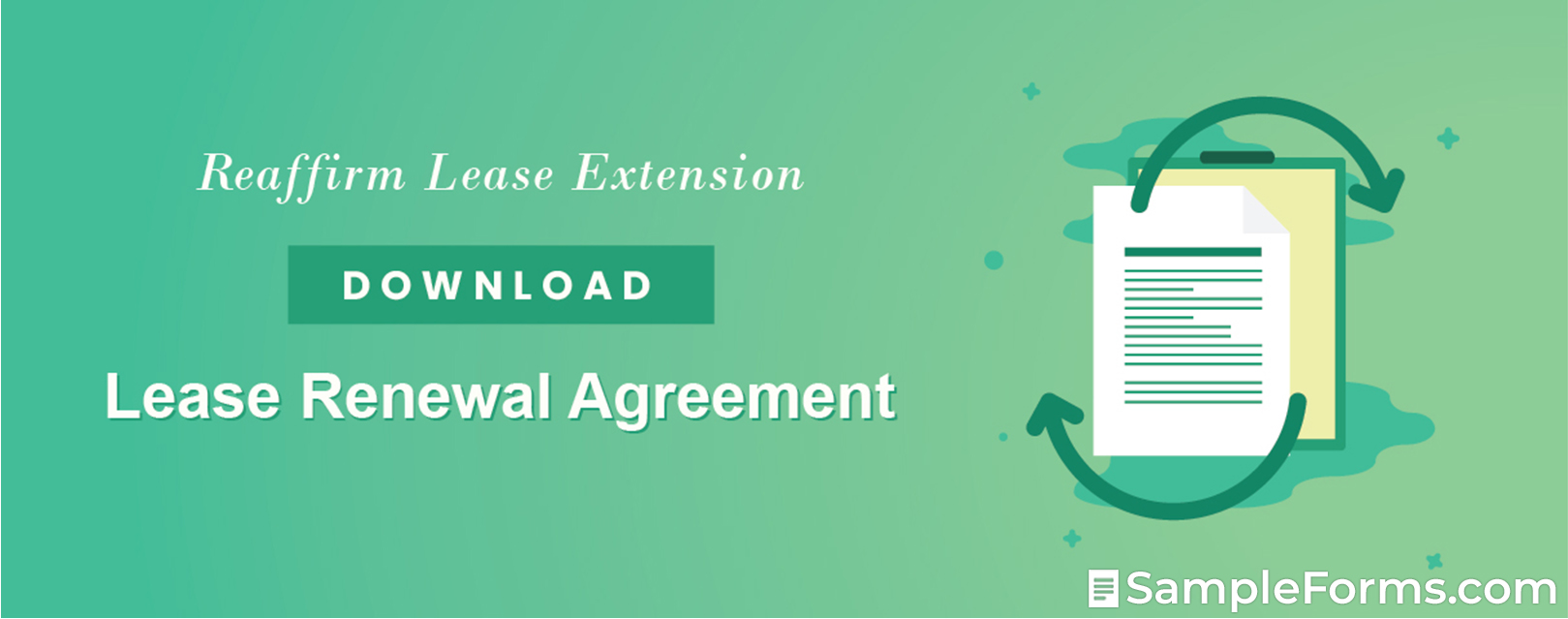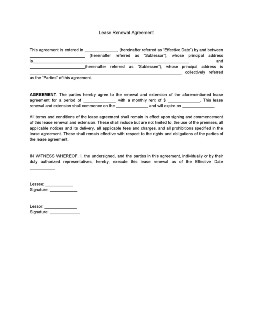- Eviction Notice Forms
- Power of Attorney Forms Forms
- Bill of Sale (Purchase Agreement) Forms
- Lease Agreement Forms
- Rental Application Forms
- Living Will Forms Forms
- Recommendation Letters Forms
- Resignation Letters Forms
- Release of Liability Agreement Forms
- Promissory Note Forms
- LLC Operating Agreement Forms
- Deed of Sale Forms
- Consent Form Forms
- Support Affidavit Forms
- Paternity Affidavit Forms
- Marital Affidavit Forms
- Financial Affidavit Forms
- Residential Affidavit Forms
- Affidavit of Identity Forms
- Affidavit of Title Forms
- Employment Affidavit Forms
- Affidavit of Loss Forms
- Gift Affidavit Forms
- Small Estate Affidavit Forms
- Service Affidavit Forms
- Heirship Affidavit Forms
- Survivorship Affidavit Forms
- Desistance Affidavit Forms
- Discrepancy Affidavit Forms
- Guardianship Affidavit Forms
- Undertaking Affidavit Forms
- General Affidavit Forms
- Affidavit of Death Forms
Lease Renewal Agreement
Lease renewals are a great way of keeping outstanding tenants. Renewals are also useful in controlling tenants that defy rules and keep them away from your property, aside from screening their rental applications. In doing so, you should always document—as well as certify such an extension of tenancy in writing. The best way to do that is through completing a lease renewal agreement. Read More
Lease Renewal Agreement
- When do we create a lease renewal agreement?
- Are we allowed to change the original lease in a lease renewal agreement?
- Do I need to talk and ask my tenant before creating a lease renewal agreement?
- Can I deny a tenant’s request for lease renewal?
- Is it okay to change the tenant’s rent in a lease renewal agreement?
What Is a Lease Renewal Agreement?
A lease renewal agreement is a document that records the extension of a tenant’s lease term. This agreement sets another lease term and does not change the terms and conditions of the original lease.
This agreement may also indicate an increase or decrease in the rent, depending on the present economic condition. Anything else that needs to be changed will require the creation of a new lease agreement or an addendum later on.
How to Create a Lease Renewal Agreement
A lessor can offer a renewal as an option to the tenant upon creating the original lease agreement. But, it can also be through an addendum on top of the original lease agreement. Either way, you need to agree on a lease renewal beforehand if the tenant wishes to extend their tenancy or if the lessor offers so. Listed on the steps below is how to create a lease renewal agreement.
1. Introduce the Parties to the Lease
The parties of a lease renewal agreement are the same as the original lease. And since this agreement serves to document the extension of a tenants lease, it is also essential to introduce the same parties as well. It indicates those subject to the extension or those bound by its terms and conditions.
2. Outline the Specifics of the Lease Renewal
Next, outline the specifics of the lease renewal after introducing the parties of this agreement. This entails the setting of a new lease term, commencement date, as well as its expiry date. A change in the rental fee may also be in the lease extension agreement provided that you and the tenant discussed such a change.
3. State the Validity of the Original Lease
Aside from extending and setting a new lease term, a lease renewal agreement also retains the validity of the terms and conditions of the original lease. Doing so also extends to the use of the premises, prohibitions, applicable fees, notices, and other provisions of the original lease. It’s essential to include such a statement when creating a lease renewal agreement, or your tenant may construe the renewal as otherwise.
4. Sign the Lease Renewal Agreement
A lease renewal agreement is a straightforward and concise agreement. So after completing all the previous steps, it’s time for you and your tenant to sign the lease renewal agreement. Signing this agreement indicates that you and the tenant agree and understand the specifics of the renewal with full acceptance. Furthermore, it also shows that both of you still abide by the terms and conditions of the original lease.
5. Create an Addendum For any Other Changes
Although creating an addendum is not included in creating a lease renewal agreement, it may also come in handy if you and the tenant agree on some changes to the original lease agreement. An addendum is a document that is attached to the original deal in case some of its provisions or clauses need to be changed, such as additional privileges and many others.
Frequently Asked Questions
When do we create a lease renewal agreement?
A landlord uses a lease renewal agreement every time a tenant’s lease term is about to expire. Furthermore, lease renewal agreements are created before the expiry of the original lease term.
Are we allowed to change the original lease in a lease renewal agreement?
No. A lease renewal agreement only extends or renews the original lease term as well as the rental amount, to some extent. This agreement, however, keeps the terms and conditions of the original lease intact and, in effect, upon commencement of the new lease term. Any changes to the original lease will require the attachment of an addendum or the creation of a new lease agreement.
Do I need to talk and ask my tenant before creating a lease renewal agreement?
Yes. You need to discuss any wishes to renew the lease agreement and its term with the tenant. You’d also want to verify if they’re fine with any changes to the rental amount. Finally, it is also important to talk to the tenant even if they’re the ones that requested it.
Can I deny a tenant’s request for lease renewal?
Yes. Lease renewals offer several benefits, such as allowing you to keep good tenants and continue to have a stable source of income. And, denying such a request also allows you to keep bad tenants away from your property as well. This is especially if they’re doing more harm than good to your property and business.
Is it okay to change the tenant’s rent in a lease renewal agreement?
Yes. Changing a tenant’s rent is often necessary as the cost of maintaining your property doesn’t always stay the same. These changes are fine as long as the tenant is aware and as long as both of you discussed it before creating a lease renewal agreement. Any changes other than that of the rental amount will require the attachment of an addendum to th original lease.
Landlords offer lease renewals as a privilege to tenants who proved to be trustworthy. However, it can also be your last line of defense against those who are delinquent and problematic. After all, granting such privilege needs to be properly documented in writing, and you can do so by creating a lease renewal agreement.

